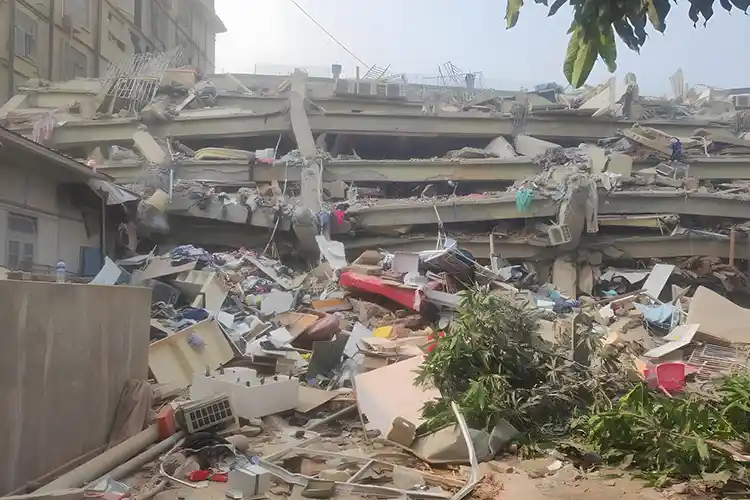
7.7-magnitude quake devastates Mandalay region and historic Bagan temples; tremors felt across Southeast Asia
A powerful 7.7-magnitude earthquake struck central Myanmar on 28 March 2025, leading to catastrophic destruction and a rapidly escalating death toll. The quake’s epicentre was near Sagaing, approximately 20 kilometres from Mandalay, at a shallow depth of 10 kilometres, which intensified its impact across the region.
Casualties and Damage
- Myanmar: As of 29 March, official reports from Myanmar’s military government indicate at least 1,600 fatalities, over 2,376 injuries, and 30 individuals missing. Mandalay, the country’s second-largest city, bore the brunt of the devastation, with numerous buildings, bridges, and roads collapsing. The international airport in Naypyidaw sustained significant damage, disrupting relief efforts.
- Thailand: The tremors extended to neighbouring Thailand, where a 34-storey building under construction in Bangkok collapsed, resulting in at least 10 deaths and numerous injuries. The Thai government has declared Bangkok a disaster area and is conducting search and rescue operations.
I
Interernational Response
Myanmar’s ruling military junta has declared a state of emergency in six regions and made a rare appeal for international assistance. The United Nations, World Health Organization, and Red Cross are mobilizing aid efforts. The United States has pledged support, with disaster experts from USAID on standby. Other countries, including India, China, and Russia, have dispatched rescue teams and relief supplies to assist in the affected areas.
Challenges and Concerns
The earthquake has compounded Myanmar’s existing humanitarian crises, including political instability and ongoing civil conflict. Access to affected regions is severely hampered by damaged infrastructure and security concerns. There are fears that the military junta may obstruct or manipulate humanitarian efforts, prompting calls for aid to be delivered through local organizations and opposition groups to ensure it reaches those in need.
Aftershocks and Ongoing Risk
Seismologists warn of potential aftershocks in the coming days, which could cause further damage to already weakened structures and pose additional risks to survivors and rescue teams. Residents are advised to remain vigilant and follow guidance from local authorities.
The full extent of the disaster is still unfolding, with rescue operations ongoing and casualty figures expected to rise. The international community’s response will be critical in addressing the immediate needs of the affected populations and supporting Myanmar’s long-term recovery efforts.
Among the hardest-hit areas was Bagan, Myanmar’s ancient city and UNESCO World Heritage site. Hundreds of temples and pagodas, some dating back to the 11th century, suffered severe damage or collapse. ‘This is a national tragedy,’ said a spokesperson for Myanmar’s Department of Archaeology. ‘Many of these structures were already fragile, and now countless have been lost.’
The powerful tremors extended beyond Myanmar’s borders, causing damage and panic in neighbouring nations. In Thailand, a 34-storey building under construction in Bangkok collapsed, killing at least ten people and injuring dozens more. Widespread shaking led to evacuations across the capital, with structural assessments now underway. Northern Thailand, Laos and parts of Yunnan Province in China also reported cracked walls, minor landslides and temporary power outages. While no fatalities were reported in Laos or China, emergency services were deployed as a precaution. The regional impact underscores the wide radius of the quake’s force and its cross-border consequences.
The Bagan Temples
The ancient city of Bagan, home to one of the world’s richest collections of Buddhist architecture, has suffered catastrophic damage in the 28 March earthquake. Early reports suggest that hundreds of pagodas and temples, some over 1,000 years old, have collapsed or been severely cracked.

Bagan, located in Myanmar’s Mandalay Region, was once the capital of the Pagan Kingdom and is considered a spiritual heartland of the country. The area contains more than 3,500 brick and stone structures, built between the 9th and 13th centuries.
UNESCO has expressed ‘grave concern’ over the destruction, warning that many of the most significant structures – including Ananda Temple, Thatbyinnyu Temple and Dhammayangyi – may have suffered structural failure. Drone footage from the region shows toppled stupas and crumbled façades, as aftershocks continue to destabilise the area.
This is not the first time Bagan has been hit hard – a 6.8-magnitude quake in 2016 caused widespread damage. But this event is already being described by archaeologists as ‘the most devastating blow to Myanmar’s heritage in living memory.‘
Access to the site is currently restricted, with emergency crews working to stabilise structures and prevent further collapse. UNESCO is coordinating with local experts to begin rapid assessments as soon as conditions allow.




